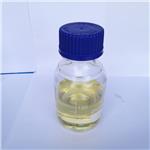2-Ethyl-3-propyl acrolein is a colorless or
yellowish liquid with a sharp, powerful, irritating odor
colourless liquid with a strong smell
Insecticide, organic synthesis (intermediate),
warning agents, and leak detectors.
ChEBI: 2-ethyl-2-hexenal is a monounsaturated fatty aldehyde that is hex-2-enal substituted by an ethyl group at position 2. It has a role as a plant metabolite, a human metabolite and a flavouring agent. It is a monounsaturated fatty aldehyde and an enal.
Yellow liquid. Floats on water.
2-ETHYL-2-HEXENAL is an aldehyde. Aldehydes are frequently involved in self-condensation or polymerization reactions. These reactions are exothermic; they are often catalyzed by acid. Aldehydes are readily oxidized to give carboxylic acids. Flammable and/or toxic gases are generated by the combination of aldehydes with azo, diazo compounds, dithiocarbamates, nitrides, and strong reducing agents. Aldehydes can react with air to give first peroxo acids, and ultimately carboxylic acids. These autoxidation reactions are activated by light, catalyzed by salts of transition metals, and are autocatalytic (catalyzed by the products of the reaction). The addition of stabilizers (antioxidants) to shipments of aldehydes retards autoxidation. 2-ETHYL-2-HEXENAL will react with oxidants.
Toxic by inhalation and ingestion; strong
irritant.
Vapor is irritating. Contact produces skin and eye irritation.
Flammability and Explosibility
Not classified
Those workers involved in organic
synthesis operations and use of this flammable and toxic
aldehyde warning agent.v
UN1988 Aldehydes, flammable, toxic, n.o.s.,
Hazard Class: 3; Labels: 3-Flammable liquid,
6.1-Poisonous materials, Technical Name Required
Aldehydes are frequently involved in
self-condensation or polymerization reactions. These reactions are exothermic; they are often catalyzed by acid.
Aldehydes are readily oxidized to give carboxylic acids.
Flammable and/or toxic gases are generated by the combination of aldehydes with azo, diazo compounds, dithiocarbamates, nitrides, and strong reducing agents. Aldehydes
can react with air to give first peroxo acids, and ultimately
carboxylic acids. These autoxidation reactions are activated
by light, catalyzed by salts of transition metals, and are
autocatalytic (catalyzed by the products of the reaction).
The addition of stabilizers (antioxidants) to shipments
of aldehydes retards autoxidation. Incompatible with
oxidizers (chlorates, nitrates, peroxides, permanganates,
perchlorates, chlorine, bromine, fluorine, etc.); contact may
cause fires or explosions. Keep away from alkaline materials, strong bases, strong acids, oxoacids, epoxides, caustics,
ammonia, and amines
Incineration, or dissolve in
flammable solvent and spray into incinerator containing
afterburner



